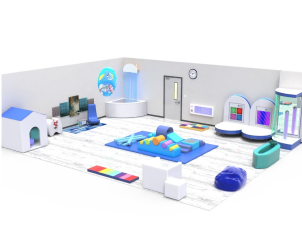Key Components of a Successful Sensory Corner
Good things come in all shapes and sizes. While it’s tempting to believe that your child will benefit most from an entire sensory room, a dedicated sensory corner can be equally beneficial! How do you know what to include? It’s important to make the most effective use of limited space, so we’ve broken down the key components for you to design the ultimate sensory corner for your kids.
1. Multifunctional
There’s no magic tool that will help in every situation, as much as we sometimes wish there was. Keeping your sensory corner stocked with a balanced variety of active and calming tools is a great way to provide your kids with everything they need. Try letting out some energy on a Jumping Board, then decompressing in the Cozy Canoe.
2. Easy to use
Creating a safe space for your kids means that they should be able to use it with as much independence as possible. Avoid any complicated equipment or activities that need an adult’s help to use. Making sure the space is easy to use will likely make it more appealing to your child. Additionally, this teaches kids self-regulation, so that they feel empowered to know what their sensory system needs and can seek it out
3. Easy to clean
Messes happen. We have spent our fair share of time cleaning up after our kids, too. Choosing items that are made of wipe-clean PVC fabric means that everyone is more likely to use them, and even help clean them! Spray bottles are a great fine motor strengthener, as well as fun for kids to use. Put everything in the sensory corner back where it belongs, so that you can start fresh the next day. Giving your kids responsibility also fosters independence and teaches them about chores and keeping their space clean, which can lead to better use of it for self-regulation.
4. Visual choice board
Sometimes when faced with many choices, kids feel overwhelmed and cannot figure out what they need. To prevent this, have a board with pictures of each item available in the sensory corner. Kids can look at the board and choose what tool will be most helpful for their sensory systems, rather than wandering around unable to decide what they need. You can even keep the board right outside the sensory corner so they know exactly where they’re headed when they get there.
5. Grows with you
When you invest in a sensory corner, you want it to last. We recommend choosing tools that are appropriate for a range of ages and stages of development, so that your kids can continue using them for longer.
6. Clear rules and expectations
We want kids to have fun and be safe, which are both easier to achieve when everyone understands the expectations. Discuss the rules of the sensory corner with your kids before opening it for use. For example, no shoes on, one child at a time, or using a timer to take turns in the space. You can always revise the rules as needed. In general, though, kids can have more fun without worried parents breathing down their necks.
As you go through the process of designing the space that’s right for you, remember that everyone’s needs are different. We’d love to hear what works best for your kids’ sensory needs. Share what was a flop and what was a success in the comments!
























Comments